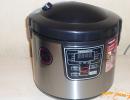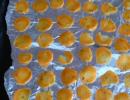Types of sore throat in children and treatment methods
Purulent tonsillitis is an infectious inflammation of the lymphadenoid tissue of the tonsils in a child. Various types of sore throat in children occur due to exposure to bacteria, viruses, and fungi. How to treat purulent tonsillitis depends on its type, severity and age of the baby.
To understand the causes of sore throat in a child, you need to know the mechanism of this disease. Tonsils are lymph nodes located in the throat, also called tonsils. The tonsils act as filters, killing foreign viruses and bacteria that enter the body.
The main causes of sore throat are bacterial factors. When there are a lot of microorganisms, the tonsils cannot cope with them. Then their size increases, and the inflammatory process begins.
The causes of sore throat are quite simple:
- The baby is not eating well;
- Rarely walks outside;
- Doesn't breathe fresh air;
- Does not exercise;
- There are not enough vitamins in the diet.
Factors that cause sore throat:
- Weakened immunity;
- Previous viral diseases;
- Inflammation of the nasopharynx;
- Hypothermia.
The causes of frequent diseases of purulent tonsillitis are the rapid transmission of the pathogen by airborne droplets. The virus enters the body during conversation, sneezing, and through common household objects. Incorrect treatment of sore throat in children leads to, and the causative agent of the disease, streptococcus, causes allergies, pathologies of the kidneys, vascular system and heart.
Kinds
The extent to which the tonsils are affected indicates the type of sore throat. Sore throat in children can be acute or chronic. Acute purulent tonsillitis develops rapidly over several days. Plaque, pus or rashes appear on the inflamed tonsils, the type of which determines the type of sore throat in a child.
With chronic tonsillitis, there are no serious changes in the tonsils, so the disease can be confused with ARVI. In rare cases, acute tonsillitis quietly takes on a chronic form. This disease is called primary chronic.
Catarrhal
Catarrhal sore throat occurs very rarely. At first, the disease is acute: the throat becomes dry, a burning sensation is felt, then pain appears during swallowing and high fever. The tonsils become enlarged and their surface is covered with a white coating. The palate becomes red, the head hurts, and intoxication increases. Symptoms disappear after 5 days from the onset of the disease.
Follicular

occurs in an acute form. The first symptoms appear within a couple of hours after infection. The temperature remains high above 38 degrees. The sore throat radiates to the ear, and there is strong salivation.
In addition to the main symptoms, the child may experience vomiting, signs, and loss of consciousness. The lymph nodes in the neck become large and painful. The tonsils are covered with yellow or gray dots.
After a couple of days, the abscesses open, erosions form, which quickly heal. After opening the abscesses, the temperature returns to normal and the follicular sore throat goes away within 1 week.
Lacunarnaya

occurs after penetration into the body, symptoms are similar to follicular. The symptoms are more pronounced - the onset is acute, the temperature increases and lasts for a long period.
The entire surface of the tonsils is covered. When the plaque separates, the temperature does not decrease. Until the lymph nodes return to their previous size, the baby will be weak, have a fever and experience intoxication. If there are no complications, then lacunar tonsillitis goes away in 5 days. With complications, the duration of the disease increases significantly.
Fibrinous

Fibrinous tonsillitis is similar in symptoms to follicular and lacunar tonsillitis. The significant difference is that the tonsils are enveloped in a white, transparent purulent film. This manifestation is similar to and many experts confuse these diseases. To establish the correct diagnosis, special smear examinations of the tonsils are performed. The patient is ill for 7 days after the first signs of fibrinous tonsillitis are detected in the child.
Phlegmonous

The phlegmonous form develops as a result of complications of lacunar and follicular tonsillitis. The tissues of the tonsils fill with pus, as in lacunar tonsillitis. There is a high temperature that lasts a long time, severe, and loss of appetite.
The baby has a hoarse voice and his speech is incomprehensible. Feeling better when the abscess breaks through. There may be a breakthrough of purulent masses into the throat. As a result, a purulent leak forms. Often, phlegmonous tonsillitis affects one side of the tonsils. The baby has been sick for 12 days.
Atypical
With atypical tonsillitis, the tonsils are affected by various bacteria, viruses, and fungi, which under normal conditions are not pathogenic. Symptoms are similar to the types listed above. The disease develops quickly. The throat becomes inflamed and sore, the temperature rises. Atypical sore throat goes away within a week from the onset of infection.
Simanovsky
Simanovsky-Plaut-Vincent angina is the most severe. It develops due to the activity of the natural microflora of the oral cavity, which is normally not pathogenic. Usually the disease forms when the body is weakened, poor nutrition, etc. Necrosis of the palatine tonsils occurs. There is a significant temperature, there is a rotten smell from the mouth.
Fungal

occurs against the background of oral candidiasis in a child. The temperature stays up to 38 degrees, the mucous membrane of the mouth and tonsils are covered with a white coating of curd consistency. It occurs quickly, in a mild form and disappears within a week.
Herpes
In children it is characterized by a long latent period, about 5 days. easily transmitted to others through coughing and touching. There is a feverish state and temperature up to 40 degrees. The throat hurts, diarrhea and vomiting appear. Red bubbles are visible on the tonsils, which after a while burst and form ulcers. When the ulcers heal, the patient's condition returns to normal.

Mixed
During mixed sore throat, lymphoid tissue is immediately attacked by several pathogens. In some cases, a secondary bacterial infection is attached. Fungi are attached to the bacteria that provoked the disease. Mixed tonsillitis in children is dangerous due to severe complications.

Symptoms
General symptoms that are characteristic of all types of sore throat:
- Fever;
- Weakness of the whole body;
- Pale skin;
- Poor appetite;
- Fever;
- Inflamed tonsils;
- Intoxication;
- Salivation.
If you notice symptoms of a sore throat in a child, you should definitely make an appointment with a doctor. The diagnosis is made after a medical examination. Prescribed to determine the causative agent of the disease. A sore throat should be treated immediately to prevent complications from developing.
Treatment
Sore throat is a rather dangerous disease and it can be difficult to cure. Treatment can even be done surgically.
It is impossible to cure a bacterial sore throat without the use of antibiotics, but with a viral sore throat, antibacterial agents, on the contrary, are useless.
An effective way to cure a sore throat is the use of several methods of therapy simultaneously - local and general.
Antibiotics
are used to kill streptococcal infections. It is necessary to stop at penicillin antibiotics; they are well tolerated and can be taken regardless of food. It is forbidden to give antibiotics to a child without the advice of a specialist.
The effective use of antibiotics such as:
- Ampioxa;
- Flucloxacillin.
If a child is diagnosed with penicillins, then drugs from other groups are used:
- Azitrox;
- Zithrolyl.
Cephalosporins are rarely prescribed:
The course of antibiotic treatment is 7-10 days. For Sumamed, the course of treatment is 5 days. The effect of antibiotics is assessed after a few days. The improvement is visible in the general condition of the patient. The temperature drops, the throat stops hurting, and the tonsils decrease in size.
The use of antibiotics destroys the beneficial microflora of the body. The child may develop dysbiosis.
Other drugs

Operation
Removal of tonsils for angina is prescribed in the most critical situation, but only after the acute inflammation has been eliminated. Extensive damage to the tissues of the tonsils during purulent tonsillitis is subject to exception.
Tonsillectomy is prescribed during:
- Recurrent tonsillitis, occurring about 5-7 times a year for 2 years;
- Decompensated form of chronic tonsillitis;
- which causes complications on the heart and kidneys;
- Failures in the respiratory system due to severe damage to the tonsils;
- Purulent complications of tonsillitis.
Folk remedies
When a child suffers from a mild form of sore throat, you can use folk remedies and carry out treatment at home.
Compresses

A good folk remedy is. You can place fresh cabbage leaves on the throat area and insulate it with a warm sweater or scarf. A compress made from honey, mustard, alcohol, oil, flour and water is considered an effective remedy. Mix all ingredients thoroughly. Warm up the mass a little, then place it in gauze and apply it to the throat. If desired, you can wrap it up and keep it there for about two hours.
Rinse
Rinsing is easy to do at home. For the procedure, take a few cloves of garlic, chop well and pour a glass of boiled water. Gargle your child's throat every hour.
For the treatment of purulent sore throat, rinsing with herbal infusions: chamomile, calendula, sage are well suited. You can use salt and soda for rinsing. Rinse about 6 times a day. During the procedure, the tonsils are cleared of pus and dead tissue.
- Interesting read:
Inhalations
Can be done when there is no high temperature. A folk remedy for inhalation is a decoction of pine buds. To prepare the solution, dilute 20 g of crushed buds in a glass of boiling water. You can make inhalations from thyme. Take 2 teaspoons of thyme and add hot water, leave for an hour. Pour the hot decoction or tincture into a container, cover the baby with a towel and let it breathe for 5-10 minutes.
Prevention
Prevention of sore throat in children consists of hardening the body and observing the rules of personal hygiene. First of all, you need to brush your teeth properly, don’t forget about your tongue and cheeks. Teach your child to do exercises in the morning and get involved in outdoor games.
You should ventilate the room in which the baby is located at least 2 times a day. Carry out wet cleaning, use air humidifiers. Moisturizing is necessary to prevent the mucous membrane from drying out. When the mucous membranes are dry, viruses that cause sore throat spread faster.






